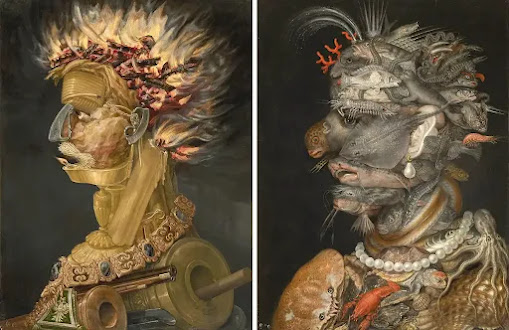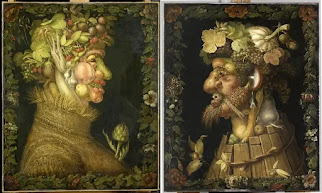Later Italian Renaissance Era Art
History
Guiseppe Arcimboldo painted The Four Elements during the Italian Renaissance while he worked as a court painter for Maximus II, Holy Roman Emperor, at the Habsburg's court in Prague. The four oil on wood paintings, Earth, Air, Fire, and Water, are crafted to depict humans and are comprised of natural elements and animals. Earth contains many different types of animals; livestock, woodland, and exotic; Air is arranged with an array of birds; Fire is formed with pyrotechnics objects and flames, and Water is swirling with aquatic life. These artwork pieces are a part of another series of four unique paintings also gifted to Maximus II, The Four Seasons, Summer, Fall, Winter, and Spring. The paintings were believed to be metaphoric family portraits of the honored Habsburg family, each season linked to its corresponding element depicting the chaos to balance the family endured. Sadly in 1684, when a Swedish army invaded Prague during the Thirty Years' War, many of Ruldoph II's paintings by Arcimboldo in his collection were stolen. In present-day, Guiseppe Arcimboldo's artwork is displayed in Vienna's Kunsthistorisches Museum, the Habsburg Schloss Ambras in Innsbruck, the Louvre in Paris, and numerous museums in Sweden.
The Four Elements was painted during the Later Years of the Renaissance in 1566 using Mannerism art techniques. Preceding the High Renaissance period, where artwork was based on realism, beauty, and precise proportions, Mannerism used those principles but exaggerated reality by showing off self-expression and skillful craft by using relationships between humans and nature. Humanistic art principles are used in Arcimboldo's The Four Elements paintings. Animals, vegetables, fruits, fish, and earth elements are woven together to form a shape resembling human faces, often exaggerating certain parts of the facial structure; the nose, cheeks, ears, and chin. He used components from parts of the objects to intensify and enhance hair, eyes, and clothing features.
I am fascinated with Guiseppe Arcimboldo's artwork; it is interesting, weird, and beautiful. My favorite aspect is the back story behind his works; they are not simply objects used to resemble human faces but carefully picked and designed to take after the subject for who he crafts them. It would be interesting to see what elements he would choose to represent me if Arcimboldo used me as a model for one of his paintings. I like to walk to the beat of my drum; Arcimboldo created these pieces following an era of artists who crafted exquisite, realistic paintings. Inspired by the High Renaissance artists, he took their ideas and designed his artwork in a unique, eye-catching style, which draws me to his work.
Texture
A bubbly round profile is built out of many different shapes of aquatic life and marine animals. The head of a seal makes a plump circular nose that makes the King breathe easier. A long oval-shaped shark, squid, and catfish build a wide bulbous mouth and chin. The tightly wrapped eel lengthens the thin neck the elegant pearl necklace encircles.
Renauld, Marie Madeleine. “Giuseppe Arcimboldo: Turning Fruit into Faces.” The Collector, 8 Nov. 2021, https://www.thecollector.com/giuseppe-acrimboldo-composite-plant-paintings/.
Renita, Shelley. “What Is Mannerism Art?” Art Facts, 19 Sept. 2022, https://art-facts.com/what-is-mannerism-art/.
Selvin, Claire. “How Giuseppe Arcimboldo Reimagined Portraiture in 16th-Century Europe.” ARTnews.com, ARTnews.com, 1 Oct. 2020, https://www.artnews.com/feature/giuseppe-arcimboldo-who-is-he-famous-works-1234572120/#!
“The Four Elements (Arcimboldo).” Wikipedia, Wikimedia Foundation, 25 Aug. 2021, https://en.wikipedia.org/wiki/The_Four_Elements_(Arcimboldo)#:~:text=The%20Four%20Elements%20is%20a%20series%20of%20four,profile%20made%20up%20from%20different%20animals%20or%20objects.
“The Four Seasons (Arcimboldo).” Wikipedia, Wikimedia Foundation, 12 Sept. 2022, https://en.wikipedia.org/wiki/The_Four_Seasons_(Arcimboldo).











Hello Megan,
ReplyDeleteI liked the art that you shared in your blog. It is so interesting that Giuseppe Arcimboldo could produce a representation of people so well by using only objects and animals. I would definitely agree that The Four Elements by Giuseppe are Mannerist paintings. They are some of the easier Mannerist paintings to identify because they emphasize the close relationship between people and animals, where the images of people are created so clearly by a number of different animals. I thought you had a pretty good analysis of The Four Elements, but I have a couple of other things to add. I feel like the gun and the cannons were incorporated into the body of “Fire” to give us a sense of destruction. Similarly to guns and canons in the middle of a war, fire destroys things. I would also like to add on, by saying that there are often fires and explosions that occur during wars. I also thought it was cool that “Water” was given such a well-shaped ear. I feel like the painter uses color on the pearls used for the necklace and the earring of “Water” so that we can see that the pearls are reflective. This gives us the sense that the person is wealthy because she has expensive, shiny jewelry.